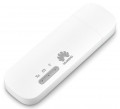Wi-Fi
Wi-Fi connection speeds, more precisely, Wi-Fi standards supported by a modem with the appropriate capabilities (see "Type", "Connection").
— Wi-Fi 3 (802.11g). A further development of the Wi-Fi 1 (802.11b) standard, developed primarily for increasing connection bandwidth (2.4 GHz) and introduced in 2003. 802.11g hardware is fully backwards compatible with 802.11b, so even the simplest of today's Wi-Fi devices support both of these standards.
— Wi-Fi 4 (802.11n). The Wi-Fi standard, which is a further development of the formats described above — in particular, by supplementing them with support of MIMO technology (distribution of input and output between several antennas). Introduced in 2009. The main operating frequency is 2.4 GHz, but there are devices supplemented with a 5 GHz band.
—
Wi-Fi 5 (802.11ac). Built on top of 802.11n, introduced late 2013. The main improvements were the increase in the number of streams at the second frequency (5 GHz) and the introduction of more advanced MIMO and modulation standards, which increased the throughput accordingly.
Connected devices, up to
The largest number of devices that can be simultaneously connected to the modem via Wi-Fi (see "Connection").
The presence of this limitation is due to the fact that processing network requests from several devices at once requires a fairly large amount of computing resources, and there are not so many of them in miniature electronics like wireless modems. However, even inexpensive models can support about 5 – 6 devices, which is more than enough for most cases; and in more advanced modems, this number can reach 10.
4G (LTE)
The 4G (LTE) mobile connection speed supported by the modem.
All modern LTE equipment is assigned one or another category (
Cat.3,
Cat.4,
Cat.6,
Cat.7,
Cat.9,
Cat.12,
Cat.13,
Cat.16,
Cat.18,
Cat.19,
Cat.20,
Cat.22), on which the transmission speed directly depends. This paragraph specifies both this category and specific speed indicators, moreover, in two parameters — for reception and for transmission. The transmission speed is always much lower, but given the specifics of mobile Internet access, this is usually not critical.
Note that equipment with different speed categories will be quite compatible with each other, however, the throughput will be limited by the capabilities of the slower device. It is also worth saying that this paragraph indicates the theoretical maximum; practical amounts can be noticeably lower (depending on the quality of the network coverage and the features of specific electronics). However, a modem with a higher speed category will perform faster in fact.
External antenna connector
The presence
of a connector for an external removable antenna in the modem design. The meaning of all external antennas is described above; here we note that the connector makes it possible to use rather large antennas with the modem, which significantly exceed the capabilities of stock antennas (both internal and external non-removable ones). In addition, the user can choose the antenna at his discretion.
MIMO antenna connection
The ability to connect the MIMO antenna (the antenna itself, usually, must be purchased separately).
MIMO technology is used in Wi-Fi communications, as well as in 4G LTE networks (starting with Cat.2). Its general principle is to split the transmitted signal into several transmitting and receiving antennas; at the same time, each of the transmitting antennas broadcasts a signal to all receiving antennas at once (or at least to several of them). This format of operation allows more efficient use of the frequency range, increases the actual data transfer rate, and also increases resistance to interference. But antennas for MIMO are rather bulky, in the case of modems it is difficult to make them built-in; and such feature is required not so often. Therefore, separate external antennas are used to work with this technology.
Note that even in portable Wi-Fi hotspots (see "Type"), this feature is used exclusively for 4G/LTE; Wi-Fi connection is provided by built-in antennas.
